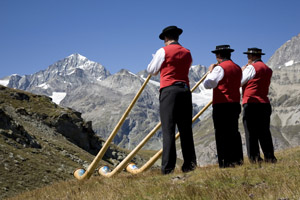
Click here to listen to Swiss Yodeling.
Yodeling is to the Alps what the Beach Boys are to Southern California, or what hog calling is to the Ozarks. But what exactly is yodeling? Compton's Encylopedia describes the yodel as "a style of singing two alternating tones, a lower one with a full voice and a higher one with a lighter falsetto voice." For a less academic description, we can turn to the classic "knock, knock" joke:
"Knock, knock."
"Who's there?"
"Little old lady."
"Little old lady who?"
"I didn't know you could yodel!"
Yodeling comes in different styles, from the undulating two-tone cries of Swiss cowherds and goatherds to the soft, mellow choral yodels of Austrian and Bavarian Adventsingen.
Nowadays, Swiss and Austrian yodeling is heard mainly in folklore festivals, tourist restaurants, or sound recordings. The local yokels are too busy making money off tourists to yodel from mountaintops. Someone has to take on the responsibility for keeping outdoor yodeling alive, so why not do it yourself? Learn about the history of yodeling, take an online course, listen to recorded examples, memorize yodeling jokes, and try a "Yodel" drink recipe by using the links on the bottom of this page. By the time you visit Switzerland or Austria, you'll be ready to impress the natives with your yodeling knowledge and ability.
Alphorn
Click here to listen to Alphorn Sound.
The alphorn is one of those instruments, like the double-bell euphonium, that non-aficionados have trouble taking seriously. Yet the alphorn has been around for nearly 500 years: first as a means of communications in the high alps, and later as a musical instrument that has been featured in works by composers like Brahms and Leopold Mozart.
Christian Schneider, alphorn maker and Webmaster of The Alphorn in Switzerland (see below), reports that a music teacher named Herr Huber organized summer alphorn courses at the request of Bern's mayor as long ago as 1826--a step that guaranteed the alphorn's survival not only as an instrument, but also as a Swiss national symbol.
As the accompanying photo shows, the alphorn is a remarkably simply instrument. It consists of a long flaring spruce tube with a mouthpiece--and that's it. No valves, no keys, no holes, no spit valve. Yet its very simplicity (as well as its size) makes it a difficult instrument to play. Christian Schneider claims that "The apprenticeship for Alphornplayers runs to approximately two years. One should be able to concentrate oneself fully on that for this time."
Herr Schneider recommends that purchasers consider the standard Fis-Ges (F-sharp/G-flat) alphorn, measuring 3.40 meters (about 11 feet) long, over other models that range from 2.2m to 3.9m in length. This size has a "clear and resonant, but also typically soft" sound, and "in its three-part construction it matches well into a car's boot." He adds that the F-sharp alphorn is well-suited for playing with organs, brass bands, and orchestras.
If you aren't ready to invest in such a specialized instrument, or to attract the attention of local cows and neighbors with two years of intensive practice, it might be wiser to simply enjoy an alphorn concert during your trip to Switzerland. Check with local tourist offices for folklore shows, especially in German-speaking Switzerland, or visit the Restaurant Stadtkeller in Lucerne.
Source: Europe for Visitors.com